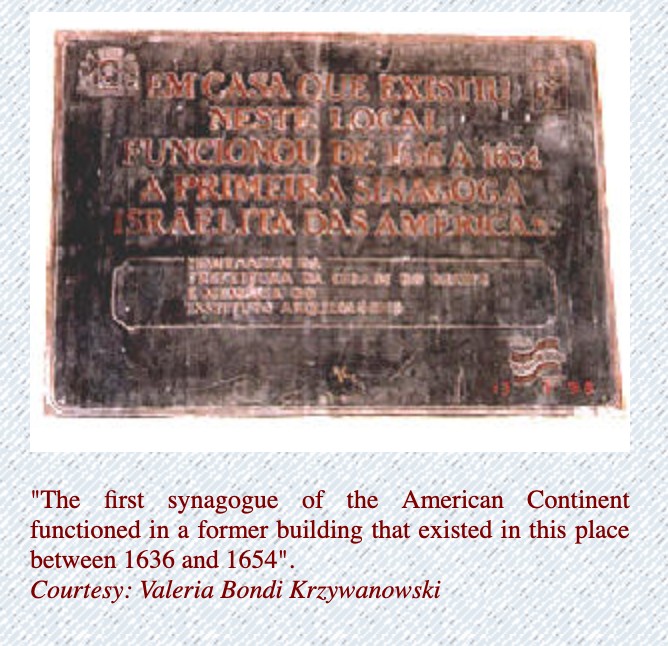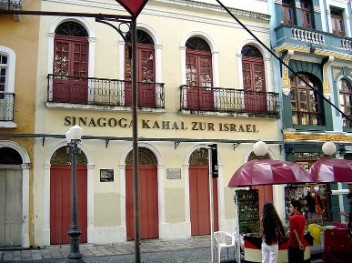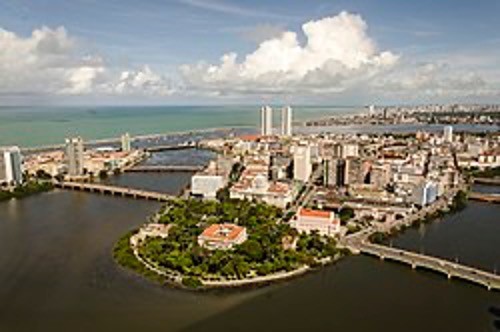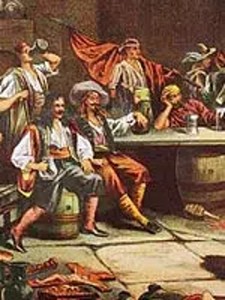Kahal Zur Israel Synagogue: Founded by Jewish Pirates and Brothers
Introduction
Text-to-speech Audio
In 1630, Captain Moses Cohen Henriques brought a Jewish contingent to the island of Itamracá and later, Recife, Brazil. After retiring from privateering (and allegedly piracy) in around 1636, Henriques helped his brother Abraham Cohen establish the Kahal Zur Israel synagogue (now an archaeological site), the first synagogue in the New World, and most likely the only synagogue in the world to have been partially founded by a pirate. Kahal Zur Israel Synagogue still serves as a Jewish community center where many local Jews will have Bnai Mitzvot or weddings to commemorate and celebrate the rich and vibrant history of the Jewish community of Recife.
Images
A stone tablet announcing the history of the building of the Kahal Zur Israel synagogue

Photo of the outside of Sinagoga Kahal Zur Israel in the present day


Painting of Dutch Portuguese pirates drinking and socializing

Backstory and Context
Text-to-speech Audio
But who was Moses Cohen Henriques? A Portuguese Jew whose family fled Portugal because of the Inquisition, he, his brother Abraham, and their nephew Jacob Cohen ended up in the Netherlands. In 1628, Henriques allegedly partnered with Admiral Piet Pieterzoon Hein, a Dutch hero, to acquire gold and silver bullion worth about 1 billion in today’s U.S. dollars from a Spanish fleet located off the coast of Cuba. At that time, this heist was the biggest the Dutch West Indies Company had ever executed. Moses Cohen Henriques notably never faced trial. Henriques was inspired by Rabbi Samuel Palache, a Moroccan and Portuguese Rabbi who became a pirate in Amsterdam to get revenge on the Spanish for the brutal and terrifying Inquisition they had implemented. Moses Cohen Henriques, like almost all Sephardic Jews at the time, spoke Ladino (a combination of Hebrew and Spanish) as well as Portuguese, and in February 1634, used his linguistic skills to ask the Dutch government if he could bring a Jewish contingent to the island of Itamracá.
One reason that the Dutch government approved his application was his success in raiding Spanish shipping. Another is that his nephew, Jacob Cohen, was the financial advisor and personal secretary to the Governor of Dutch Brazil, John Maurice, Prince of Nassau-Siegen, who was in charge of the Recife/Itamracá area. Count Mauricio gave the Jews of Recife and Itamracá complete religious freedom from 1637-1644, which was unheard of at the time for the Jewish community.
Moses Cohen Henriques succeeded in bringing a Jewish contingent of approximately 100-200 souls to Itamracá. Little is known about the Jewish community’s early activities, but we do know that they named their “synagogue” Magen Abraham (the star of Abraham) and that they lacked an official building; instead, they worshipped in the house of a man named Joshua Jesurun de Haro. When the bridge connecting the island of Itamracá to Recife was built, Magen Abraham was united with Kahal Zur Israel synagogue, bringing brother Abraham Cohen and Moses Cohen Henriques together again. The resolution to unite the synagogues was signed in 1648 and specified matters such as who would lead certain services, the dues each member would pay, and whose flour they would use to make matzah (the ceremonial unleavened bread made for the holiday of Passover in the spring). Shortly afterwards, Dutch colonial administrators recognized it as the only authorized synagogue in the Americas. When the Portuguese took over Brazil in 1654, however, they gave the Jews in Recife three months to leave. Around 1,600 Jews left for either the Netherlands or New York. The Kahal Zur Israel synagogue building was given to the leader of the Portuguese rebellion for their efforts against the Dutch.
In 2000, an excavation in Recife unearthed a mikveh (a ritual bath) proving the existence of the Jewish community of Recife and Itamracá. In 2001, thanks to Jews who had returned to Recife from the Netherlands after the Inquisition ended, the synagogue reopened. The first permanent rabbi since 1654 was brought to Recife in 2005. There are now four synagogues in the area, but most Brazilian Jews prefer to use the Kahal Zur Israel synagogue because of its historical significance and importance to the community at large. Each November, the synagogue becomes somewhat of a cultural center, presenting a Jewish festival full of dance, cinema, music, and food bringing about 20,000 visitors every year. In 2007, the president of the Israelite Federation of the State of Pernambuco, Ivan Kelner, said that the synagogue was “an enormous source of pride” for not only Brazilian Jews, but Jews all over the world.
Sources
“Synagogue in Brazilian Town Recife Considered Oldest in the Americas,” Haaretz, November 2007. https://archive.ph/20120530164916/http:/www.haaretz.com/news/synagogue-in-brazilian-town-recife-considered-oldest-in-the-americas-1.233058#selection-1441.1-1441.69.
Sellars, Christopher. 2014. “The First Synagogue in the Amreicas – Itamaraca 1634.” ESefarad, May. https://esefarad.com/the-first-synagogue-in-the-americas-itamaraca-1634/.
“The Kahal Zur Israel Synagogue, Recife, Brazil.” n.d. In The Database of Jewish Communities. https://web.archive.org/web/20071124054429/http:/www.bh.org.il/Communities/Synagogue/Recife.asp.
Viswanath, P.V. 2019. “Recife: The Cradle of Jewish America.” Faculty Working Papers. https://digitalcommons.pace.edu/lubinfaculty_workingpapers/77/.
Wiznitzer, Arnold. 1953. “The Minute Book of the Congregations Zur Isreal of Recife and Magen Abraham of Mauricia, Brazil.” Publications of the American Jewish Historical Society 42 (3): 217–302.
Lerner, Saul. 2010. “Jews and the Atlantic World: Sixteenth to Eighteenth Centuries.” Shofar 28, No. 4, (Summer 2010): 146-154.
“Jewish Pirates.” n.d. Golden Age of Piracy (blog). https://goldenageofpiracy.org/pirates/jewish-pirates.
Valeria Bondi Krzywanowski
https://commons.wikimedia.org/wiki/File:Sinagoga-kahal-zur-israel-recife.jpg
https://esefarad.com/moses-cohen-henriques-dutch-portuguese-pirate-and-sephardic-jewish/
